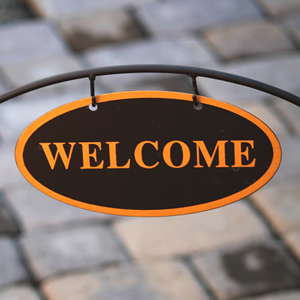We talk a lot in the arts about being “accessible” — which tends to mean open and available to many different people. The assumption (and often the experience) is that a lot of artistic work is difficult to approach and challenging to engage, whether in the content itself, or in the places and practices we share it. The frequent reaction to “accessible” is that it means “dumbing down” the work, making it less rich, less complex, and less unique so that more people will consume it. That leads conversations to an impasse.
Poet Billy Collins has an on-going skirmish with the word “accessible,” which is often used to describe his work. Because his poems are full of plain language and wry humor, many find them easier to approach than the poems of his more cryptic counterparts. But Collins isn’t fond of the word, telling PBS:
I think accessible just means that the reader can walk into the poem without difficulty. The poem is not, as someone put it, deflective of entry. But the real question is what happens to the reader once he or she gets inside the poem? That’s the real question for me, is getting the reader into the poem and then taking the reader somewhere because I think of poetry as a kind of form of travel writing.
Instead, Collins prefers the word “hospitable.” Says he to Paris Review:
There is no pre-existing reason for you to be interested in me and certainly not in my family, so there must be a lure at the beginning of a poem. I want the reader to be in the sidecar, ready. Then off we go. Then we can take a ride from what seemed to be a hospitable and friendly environment into an environment that’s perhaps disorienting, manipulative, or a little off-balancing. I want to start in a very familiar place and end up in a strange place.
Hospitable poems are no less rich, complex, murky, joyful, evocative, or dark. They just welcome you from where you are, and invite you in. As he tells The Observer, “Poetry is a mix of clarity and mystery. It’s important to know when to be clear and when to be mysterious. Too much fog is bad. Too much mist.”
While I’m not interested or authorized to tell artists how to make their work, I do a bit of business with the professionals and organizations that connect that work to the world. And there I think that Collins’ approach can carry us to a better conversation about arts experiences. It’s not necessarily about being “accessible” — like one of those easy-off/easy-on gas stations on the interstate. It’s not about being pandering or palatable. It’s about being attentive to the anxiety or apprehension of your guest, letting them know they’re welcome and they’re seen. It’s about being hospitable, a gracious and generous host for the rich (and challenging) journey ahead.
NOTE: “Accessible” here does NOT refer to the significant issue of “accessibility,” the active removal of physical, sensory, and cognitive barriers that block access to a location or an experience. However, the two are deeply intertwined, and both require a commitment to open awareness and open arms.



Hey Andrew thanks for this. Many years ago a very smart presenting colleague of mine, Ivan Sygoda, put me on to the idea of thinking about working to make the arts “legible” rather than simply “accessible.” Like Collins, his thinking was that “accessible” simply meant the door was open; but something more might be required to create a meaningful experience with the art – to make it “legible” (in the broadest sense of that word) or hospitable as you describe it.
I think of a parallel distinction when we talk about diversity, inclusion and equity. Diversity is like accessible – it’s all there. And that is the first step of course. Inclusion is similar to how you describe “hospitable” – welcoming and taking steps to insure people of all backgrounds are deliberately brought into the conversation. Equity though means recognizing that even with diversity and inclusion, we aren’t all starting from the same place. The work of equity is about repairing historic injustices and leveling the arts playing field for everyone. Much harder that diversity and even inclusion, but nonetheless critical if we really believe in “arts for all.” I’m happy to see these conversations occurring in a broader, more thoughtful context than ever before.
Thanks Ken! I like this perspective/distinction quite a lot. Much appreciated.
Thanks, Andrew. As a Billy Collins (and Ken Foster and Ivan Sygoda) fan, I’m very much in sympathy with this conversation. For years, applications to the Wisconsin Arts Board invited presenters to articulate their programming philosophies. After several iterations (due to page limitations, such applications eventually become exercises in haiku), I honed mine to this: “If you want to take people somewhere, you must first meet them where they are.”
I’ve found the notion useful far beyond the arts.
This is wonderful! I’m a concert pianist: for years I’ve spoken briefly before playing each piece of music, whether it was written 200 years ago or two, My goal is to provide what I think of as “a way in” to the work and so I speak in plain, non-academic language. It’s a great pleasure to have this additional perspective, not just from Andrew but also from Ken Foster and Jim O’Connell. Thank you all!
This is exactly how a docent in a contemporary art museum eases a guest into a meaningful conversation with a challenging artwork.